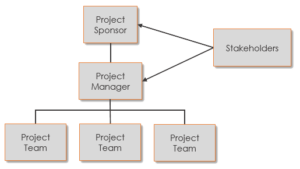
The project sponsor is a very important part of the project management organizational chart. In fact, every project has a sponsor.
The project sponsor is one, and only one, level above the project manager. They do not manage the day to day operations of the project but they ensure the resources are in place, promote the project, and hold overall responsibility for the project’s success. They represent the business side of the project. They were probably involved when the project was being conceived and advocated for its inception before a project manager was assigned.
Definition
The Project Management Body of Knowledge (PMBOK) defines a project sponsor like this:
PMBOK, 6th Edition, Page 723
Project Sponsor: A person or group who provides resources and support for the project, program or portfolio and is accountable for enabling success.
Examples
 Here are some examples of the project sponsor role.
Here are some examples of the project sponsor role.
- For a highway construction project, the project sponsor is likely employed by the state. In contrast, the project manager is employed by the construction company and submits project updates and requests funding changes from the project sponsor.
- For a house construction project, the project sponsor is likely employed by the house building company. They are probably responsible for multiple house building projects, or for the success of the company on some level. In contrast, the project manager is responsible for the day to day operations and scheduling of a house building project.
- For an I.T. project, the project sponsor might be the Chief Information Officer for the company. They receive updates and approve project changes from the project manager who is responsible for the immediate day to day project work.
Roles and Responsibilities
The project sponsor generally has the following roles:
- Promotion. They are the project champion that attempts to keep the project at the highest priority within the organization.
- Authorization. They authorize the project and assign the project manager.
- Funding. They are responsible for ensuring funding is in place and approving changes to the project budget.
- Approving. They approve the project management plan and are kept aware of how the project is managed.
- Scoping. They are generally responsible for determining the initial project scope, although the project manager is ultimately responsible for the official project scope within the project management plan.
- Project Charter. This document officially creates the project and assigns the project manager. It falls directly within the project sponsor’s responsibility.
- Informing. They receive project status updates from the project manager and disseminate the information to the relevant executives.
- Receiving. The project sponsor receives the project deliverables from the project manager, approves them, and integrates them into the owner organization.
The project sponsor is not necessarily the project manager’s boss. A common scenario is that the project owner hires an outside contractor to carry out a project, in which case the project manager works for a separate organization.
Project Sponsor vs. Project Owner
The project sponsor is a person. The project owner is the organization that performs the project and receives its deliverables. Normally the project sponsor is employed by the project owner organization.
Project Sponsor vs. Project Manager
The project sponsor is one (and only one) level above the project manager. While the project manager is responsible for the day to day operations of the project, the project sponsor seeks to promote the project to keep it high on the priority list, ensures the resources are in place to perform the project, and approves changes to the project.
| Project Sponsor | Project Manager | |
|---|---|---|
| Day to Day management of project work | No | Yes |
| Project Deliverables | Accepts | Produces |
| Funding | Approves | Requests |
Other Members of the Project Organization Chart
The project sponsor sits at the top of the project organizational chart. In effect, everyone within the project reports to them, even if through the project manager. The other members of a project organization chart are:
- Project Manager: Responsible for the day to day project work, keeping the project on schedule and budget. They report to the Project Sponsor.
- Project Team: The people who perform the technical project work and produce the deliverables. They report to the project manager.
- Customers/Users: The people who use the project deliverables to improve their lives or work. They are sometimes involved directly within the project in the form of focus groups or test subjects.
- Vendors: The people and organizations the project procures to provide products and/or services to fill technical gaps in the project team’s knowledge or ability, or to enhance the quality of the final product.
- Business Partners: The people or organizations that the project owner partners with to fulfill a specific role like installation, training or support.
- Functional Managers: The managers of technical groups (departments) within the owner organization, who often supply technical expertise to the project.
- External Stakeholders: Most project have stakeholders who are affected by the project, like government regulatory agencies, adjacent landowners, and the like.






